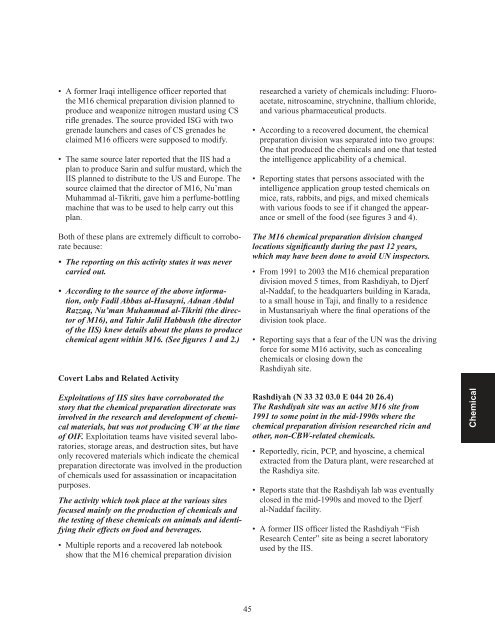Comprehensive Report
GPO-DUELFERREPORT-3
GPO-DUELFERREPORT-3
- No tags were found...
Create successful ePaper yourself
Turn your PDF publications into a flip-book with our unique Google optimized e-Paper software.
• A former Iraqi intelligence officer reported that<br />
the M16 chemical preparation division planned to<br />
produce and weaponize nitrogen mustard using CS<br />
rifle grenades. The source provided ISG with two<br />
grenade launchers and cases of CS grenades he<br />
claimed M16 officers were supposed to modify.<br />
• The same source later reported that the IIS had a<br />
plan to produce Sarin and sulfur mustard, which the<br />
IIS planned to distribute to the US and Europe. The<br />
source claimed that the director of M16, Nu’man<br />
Muhammad al-Tikriti, gave him a perfume-bottling<br />
machine that was to be used to help carry out this<br />
plan.<br />
Both of these plans are extremely difficult to corroborate<br />
because:<br />
• The reporting on this activity states it was never<br />
carried out.<br />
• According to the source of the above information,<br />
only Fadil Abbas al-Husayni, Adnan Abdul<br />
Razzaq, Nu’man Muhammad al-Tikriti (the director<br />
of M16), and Tahir Jalil Habbush (the director<br />
of the IIS) knew details about the plans to produce<br />
chemical agent within M16. (See figures 1 and 2.)<br />
Covert Labs and Related Activity<br />
researched a variety of chemicals including: Fluoroacetate,<br />
nitrosoamine, strychnine, thallium chloride,<br />
and various pharmaceutical products.<br />
• According to a recovered document, the chemical<br />
preparation division was separated into two groups:<br />
One that produced the chemicals and one that tested<br />
the intelligence applicability of a chemical.<br />
• <strong>Report</strong>ing states that persons associated with the<br />
intelligence application group tested chemicals on<br />
mice, rats, rabbits, and pigs, and mixed chemicals<br />
with various foods to see if it changed the appearance<br />
or smell of the food (see figures 3 and 4).<br />
The M16 chemical preparation division changed<br />
locations significantly during the past 12 years,<br />
which may have been done to avoid UN inspectors.<br />
• From 1991 to 2003 the M16 chemical preparation<br />
division moved 5 times, from Rashdiyah, to Djerf<br />
al-Naddaf, to the headquarters building in Karada,<br />
to a small house in Taji, and finally to a residence<br />
in Mustansariyah where the final operations of the<br />
division took place.<br />
• <strong>Report</strong>ing says that a fear of the UN was the driving<br />
force for some M16 activity, such as concealing<br />
chemicals or closing down the<br />
Rashdiyah site.<br />
Exploitations of IIS sites have corroborated the<br />
story that the chemical preparation directorate was<br />
involved in the research and development of chemical<br />
materials, but was not producing CW at the time<br />
of OIF. Exploitation teams have visited several laboratories,<br />
storage areas, and destruction sites, but have<br />
only recovered materials which indicate the chemical<br />
preparation directorate was involved in the production<br />
of chemicals used for assassination or incapacitation<br />
purposes.<br />
The activity which took place at the various sites<br />
focused mainly on the production of chemicals and<br />
the testing of these chemicals on animals and identifying<br />
their effects on food and beverages.<br />
• Multiple reports and a recovered lab notebook<br />
show that the M16 chemical preparation division<br />
Rashdiyah (N 33 32 03.0 E 044 20 26.4)<br />
The Rashdiyah site was an active M16 site from<br />
1991 to some point in the mid-1990s where the<br />
chemical preparation division researched ricin and<br />
other, non-CBW-related chemicals.<br />
• <strong>Report</strong>edly, ricin, PCP, and hyoscine, a chemical<br />
extracted from the Datura plant, were researched at<br />
the Rashdiya site.<br />
• <strong>Report</strong>s state that the Rashdiyah lab was eventually<br />
closed in the mid-1990s and moved to the Djerf<br />
al-Naddaf facility.<br />
• A former IIS officer listed the Rashdiyah “Fish<br />
Research Center” site as being a secret laboratory<br />
used by the IIS.<br />
Chemical<br />
45


